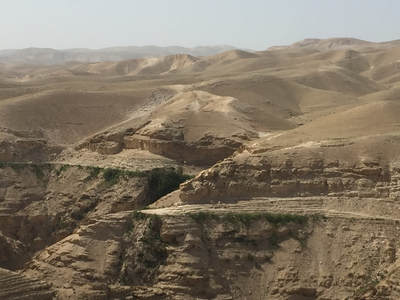We started the day in the Dead Sea – which was 1411 meters below sea level and ended the day in Jerusalem – which is 2470 feet above seal level. That is an elevation change of almost 4000 feet. Needless to say we spent the day going “up.” Along the way we stopped at fantastic sites in Masada and En Gedi. Both have historic significant and are truly marvelous natural landmarks.
Much of this route ran parallel to the ancient pathway between Jericho and Jerusalem. Pilgrims from Galilee would have bypassed the most direct route to Jerusalem in order to avoid their long term enemies – the Samaritans. Most people associate the term “Samaritan” with a story that Jesus told in which the Samaritan did something unexpectedly “good.” But if we are not familiar with the historic context we can easily miss the main assumption of the story. That is – no one expected a Samaritan to be “good”, especially to a Jewish person. This historic enemies had a long history of mistreating each other.
The ancient road from Jericho to Jerusalem runs along a valley known as a “wadi.” Water would be available in this valley more frequently and would provided necessary nourishment for both the travelers and their pack animals. We pulled of the main highway to catch a glimpse of the landscape. At the ruins of an old monastery we bartered with Bedouin merchants for trinkets and fruit. This nomadic people still live in the desert and like to trace their lineage all the way back to the patriarchs. Seeing the remoteness of this passageway emphasizes why it made sense for the traveler in Jesus’ story to get attacked on the road between Jericho and Jerusalem. It also gives a vivid picture of why the many psalms that were written about the approach to Jerusalem are called the “Psalms of Ascent.” This final leg of the pilgrimage to Jerusalem was literally one long “ascent.” One of them was particularly relevant for travelers in a dangerous country:
I lift up my eyes to the hills.
From where does my help come?
My help comes from the LORD,
who made heaven and earth.
(Psalm 121, a psalm of ascent)
This route is also the path that Jesus and his disciples took during his fateful trip to Jerusalem. It was in Jericho that Jesus met a “wee little man” called Zacheus and brought salvation to the house of this rich outcast. From there, Luke tells us simple that Jesus continued his journey:
And when he had said these things, he went on ahead, going up to Jerusalem. (Lk. 19:28)
It was there that his earthly ministry would take a deadly turn and Jesus would complete his greatest work. It is a reminder that danger is not limited to the road to Jerusalem. For Jesus the greatest danger awaited him after his arrival to this fortified city. We will see more of that the next two days.


